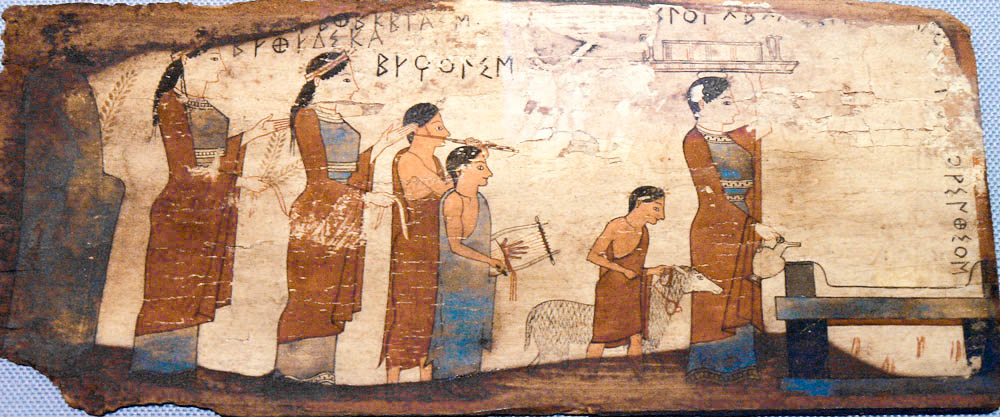Pitsa Panels from Corinth, Greece 540 BCE
"The Pitsa panels or Pitsa tablets are a group of painted wooden tablets found near Pitsa, Corinthia (Greece). They are the earliest surviving examples of Greek panel painting."
-taken from wikipedia
"Polychrome artefacts and paintings represent a crucial field of investigation to our understanding of the socio-cultural contexts in ancient Mediterranean over a long time span, from the Bronze Age to the late Hellenistic period. Painted documents from the early historical periods in Greece are extremely rare and precious. The real-time LANDIS-X scanner [1] was used for an in situ investigation at the National Archaeological Museum of Athens of the so-called Pitsa panels, four painted wooden panels dated to the Archaic period (540-530 BC) [2]. These artworks are the earliest surviving painted wooden panels hitherto known and represent a source of information of inestimable importance for the history of Western painting. The paintings were executed on thin wooden panels, over a white preparation of gesso (calcium sulphate) using a variety of pigments, including carbon black, calcium carbonate white, Egyptian blue, red and yellow ochre, cinnabar, orpiment and realgar. The application of MA-XRF imaging spectroscopy on the painted surface of the tablets brought to light extremely interesting information regarding both the distribution of pigments in the compositions and their identification. Moreover, the association of certain minor/trace elements with mineral pigmentswas revealed, whereas the thickness and the elemental chemical profile of different paint layerswas estimated by means of a full quantitative description of the respective cumulative MA-XRF spectra [3]. Elemental mapping of copper, iron, mercury and arsenic allowed us to distinguish iconographic elements that were not visible with naked eye, considerably enhancing our evaluation and interpretation of those unique testimonia of Archaic painting."
-taken from icxom24.it link below
 |
| Painted panel found at Pitsa Cave in 1934. |
Source:
https://www.wikiart.org/en/ancient-greek-painting/pitsa-panel-corinthia-greece--540
https://twitter.com/kspartiatis/status/1151507835282440192
https://edana-haukyns.livejournal.com/6796.html
http://195.251.6.78/images/library/EE4/EE4.1%20Brecoulaki.pdf
https://commons.wikimedia.org/wiki/File:Pitsa_panel_NAMA_16466_1.jpg
https://commons.wikimedia.org/wiki/File:Pitsa_panel_NAMA_16467_2.jpg
https://de.wikipedia.org/wiki/Datei:Pitsa_panel_NAMA_16465_1.jpg
https://de.wikipedia.org/wiki/Pitsa-Tafeln#/media/Datei:Pitsa_panel_NAMA_16464_1.jpg
Quote:










Comments
Post a Comment